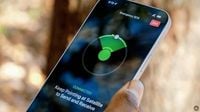Apple’s September 2025 iPhone event may have been dominated by the glitzy debut of the iPhone 17 and its new siblings, but for millions of iPhone 14 and iPhone 15 users, a quieter announcement tucked within the press releases could prove to be a real lifesaver—literally. The technology giant revealed that it is extending its free satellite connectivity features for these older models by yet another year, marking the third such extension since the launch of Emergency SOS via satellite in 2022.
According to MacRumors and The Verge, the extension means that anyone with an iPhone 14 or iPhone 15 who activated their device in a country supporting Apple’s satellite services before 12 a.m. Pacific Time on September 9, 2025, will continue to enjoy free access to these features until at least mid-September 2026. For some early adopters, that’s a full four years of free coverage—a significant upgrade from the original two-year promise made when Emergency SOS first debuted.
“The free trial will be extended for iPhone 14 and iPhone 15 users who have activated their device in a country that supports Apple’s satellite features prior to 12 a.m. PT on September 9, 2025,” Apple stated in its official newsroom posts, as reported by Engadget and MobileSyrup. For iPhone 14 owners who purchased their devices in 2022, whose free trial was set to expire in 2024, this means uninterrupted access until November 2026.
So, what exactly are these satellite features? Originally, the service was all about Emergency SOS via satellite—a way for users to contact emergency services even when they had no cellular or Wi-Fi coverage. The feature automatically notifies emergency services if an Apple Watch detects a hard fall or vehicle crash, a function that’s already credited with saving lives in remote areas. But Apple didn’t stop there. With the rollout of iOS 18, the toolset expanded to include satellite messaging, Find My via satellite, and even roadside assistance. These advances, powered by Apple’s partnership with Globalstar, mean that users can text friends or family when off the grid, share their location, and get help if their car breaks down in the middle of nowhere.
The list of supported countries continues to grow, but as of now, users in the United States, Canada, France, Germany, Ireland, United Kingdom, Australia, Austria, Belgium, Italy, Luxembourg, Netherlands, New Zealand, Portugal, Spain, Switzerland, and Japan can all take advantage of these services. However, Apple has made it clear that iPhones purchased in Armenia, Belarus, China mainland, Hong Kong, Macao, Kazakhstan, Kyrgyzstan, and Russia do not have satellite connectivity features at all. For those who bought their devices elsewhere but travel to supported regions, the features can still work while abroad, though with some caveats.
While the focus remains on emergency communication, the ability to send standard text messages via satellite when there’s no cell service is a game-changer for hikers, travelers, and anyone who ventures off the beaten path. As Lifehacker points out, users can even test out these satellite features on their iPhones by heading to Settings and selecting the demo options for Emergency SOS and Messages via satellite. It’s a handy way to get familiar with the tools before you actually need them.
Why does Apple keep extending the free period, and will it ever start charging? That’s the million-dollar question. As Engadget observed, the company has yet to announce any pricing details for satellite services after the free trial expires. Speculation abounds. One Redditor, quoted in Engadget’s coverage, summed up a popular theory: “I can’t see Apple ever charging for [Emergency SOS via satellite]. The positive PR of ‘saved by Apple’ is too good, and the negative PR of ‘died because they didn’t pay $3’ is too bad.” For now, Apple is keeping its cards close to the vest, leaving the door open to either eventual paid plans or perhaps permanent free access—at least for life-saving functions.
It’s not just iPhones getting the satellite treatment. During the same September event, Apple announced that the new Apple Watch Ultra 3 will also feature satellite connectivity, extending the reach of these critical services to even more devices. This move signals Apple’s commitment to making off-grid safety a core part of its ecosystem, not just a flashy add-on for its flagship phones.
For users, the extension is a welcome surprise. As MobileSyrup explains, “If you purchased your iPhone 14 in 2022, your free trial would have expired in 2024; however, you’ll now have Emergency SOS via Satellite until November 2026.” That’s an extra layer of security for anyone who relies on their device in remote or unpredictable environments.
Of course, the satellite features aren’t available everywhere or to everyone. Apple’s support pages and media outlets like MacRumors and Engadget reiterate that certain regions remain off-limits, mostly due to regulatory or technical barriers. Still, the expansion of supported countries and the ongoing development of new features suggest that Apple is working hard to bring these capabilities to as many users as possible.
For those eager to try out the satellite functions, the process is straightforward. To demo Emergency SOS, users can head to Settings > Emergency SOS and scroll down to “Try Demo.” For satellite messaging, it’s Settings > Apps > Messages, then scroll to “Satellite Connection Demo.” It’s a small but meaningful way to prepare for emergencies—or just to satisfy your curiosity about cutting-edge tech.
As for what comes next, only time will tell. Will Apple eventually charge for these services, or will the company decide that the goodwill and brand loyalty generated by free, life-saving features are worth more than a few extra dollars per user? For now, iPhone 14 and 15 owners can breathe a little easier, knowing that their devices have their backs—no matter where life takes them.
With the September 2025 event now in the rearview mirror, Apple’s latest move cements its reputation for prioritizing user safety and connectivity. Whether you’re a seasoned adventurer or just someone who likes to be prepared, this extension is one more reason to keep your iPhone close at hand.


